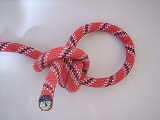
Taut-line hitch
Encyclopedia
The taut-line hitch is an adjustable loop knot
for use on lines under tension
. It is useful when the length of a line will need to be periodically adjusted in order to maintain tension. It is made by tying a rolling hitch
around the standing part after passing around an anchor object. Tension is maintained by sliding the hitch to adjust size of the loop, thus changing the effective length of the standing part without retying the knot.
It is typically used for securing tent
lines in outdoor activities involving camping
, by arborists when climbing trees, for creating adjustable moorings in tidal
areas, and to secure loads on vehicles. A versatile knot, the taut-line hitch was even used by astronauts during STS-82
, the second Space Shuttle
mission to repair the Hubble Space Telescope
.
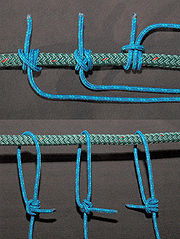 The adjustable loop forms of the rolling hitch and Magnus hitch, in addition to being called either of those two names, have also come to be known variously as the taut-line hitch, tent-line hitch, rigger's hitch, adjustable hitch, or midshipman's hitch. These knots are generally shown as being based on one of three underlying hitches: two variants of the rolling hitch (ABOK
The adjustable loop forms of the rolling hitch and Magnus hitch, in addition to being called either of those two names, have also come to be known variously as the taut-line hitch, tent-line hitch, rigger's hitch, adjustable hitch, or midshipman's hitch. These knots are generally shown as being based on one of three underlying hitches: two variants of the rolling hitch (ABOK
#1734 and #1735) and the Magnus hitch (#1736).
These three closely related hitches have a long and muddled naming history that leads to ambiguity in the naming of their adjustable loop forms as well. The use of the Ashley reference numbers for these inconsistently named hitches can eliminate ambiguity when required. See the image to the right for an illustration of these related knots.
An early use of the taut-line hitch name is found in Howard W. Riley
's 1912 Knots, Hitches, and Splices, although it is shown in the rolling hitch form and suggested for use as a stopper.
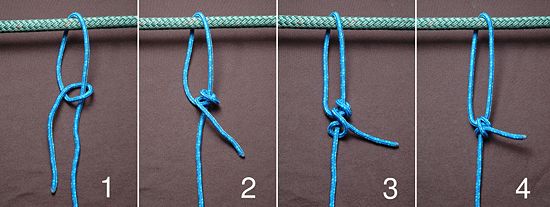
, although older handbooks
show #1855 under the taut-line hitch name.
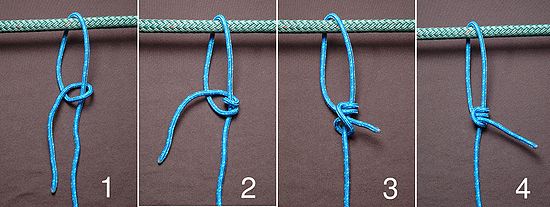
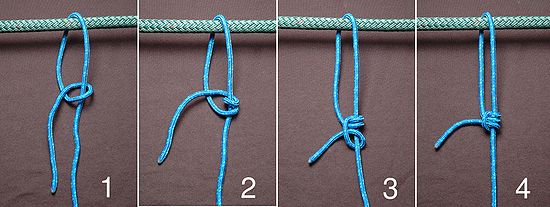
These hitches should not be depended on to hold fast under all conditions. With lines made from particularly stiff or slick modern fibers (e.g. polypropylene
) these hitches can be difficult to make hold at all. Sometimes they can be made more secure by using additional initial wraps and finishing half-hitches.
Loop (knot)
In reference to knots, loop may refer to:* One of the fundamental structures used to tie knots. Specifically, it is a full circle formed by passing the working end over itself.* A type of knot used to create a closed circle in a line....
for use on lines under tension
Tension (mechanics)
In physics, tension is the magnitude of the pulling force exerted by a string, cable, chain, or similar object on another object. It is the opposite of compression. As tension is the magnitude of a force, it is measured in newtons and is always measured parallel to the string on which it applies...
. It is useful when the length of a line will need to be periodically adjusted in order to maintain tension. It is made by tying a rolling hitch
Rolling hitch
The rolling hitch is a knot used to attach a rope to a rod, pole, or other rope. A simple friction hitch, it is used for lengthwise pull along an object rather than at right angles...
around the standing part after passing around an anchor object. Tension is maintained by sliding the hitch to adjust size of the loop, thus changing the effective length of the standing part without retying the knot.
It is typically used for securing tent
Tent
A tent is a shelter consisting of sheets of fabric or other material draped over or attached to a frame of poles or attached to a supporting rope. While smaller tents may be free-standing or attached to the ground, large tents are usually anchored using guy ropes tied to stakes or tent pegs...
lines in outdoor activities involving camping
Camping
Camping is an outdoor recreational activity. The participants leave urban areas, their home region, or civilization and enjoy nature while spending one or several nights outdoors, usually at a campsite. Camping may involve the use of a tent, caravan, motorhome, cabin, a primitive structure, or no...
, by arborists when climbing trees, for creating adjustable moorings in tidal
Tide
Tides are the rise and fall of sea levels caused by the combined effects of the gravitational forces exerted by the moon and the sun and the rotation of the Earth....
areas, and to secure loads on vehicles. A versatile knot, the taut-line hitch was even used by astronauts during STS-82
STS-82
STS-82 was a Hubble Space Telescope servicing mission by Space Shuttle Discovery. The mission launched from Kennedy Space Center, Florida, on 11 February 1997 and returned to earth on 21 February 1997 at Kennedy Space Center.-Crew:...
, the second Space Shuttle
Space Shuttle
The Space Shuttle was a manned orbital rocket and spacecraft system operated by NASA on 135 missions from 1981 to 2011. The system combined rocket launch, orbital spacecraft, and re-entry spaceplane with modular add-ons...
mission to repair the Hubble Space Telescope
Hubble Space Telescope
The Hubble Space Telescope is a space telescope that was carried into orbit by a Space Shuttle in 1990 and remains in operation. A 2.4 meter aperture telescope in low Earth orbit, Hubble's four main instruments observe in the near ultraviolet, visible, and near infrared...
.
Naming

Abok
-Burma:*Abok, Mon State - a village in south-east Burma in Mon State*Abok, Shan State - a village in north-east Burma in Shan State...
#1734 and #1735) and the Magnus hitch (#1736).
These three closely related hitches have a long and muddled naming history that leads to ambiguity in the naming of their adjustable loop forms as well. The use of the Ashley reference numbers for these inconsistently named hitches can eliminate ambiguity when required. See the image to the right for an illustration of these related knots.
An early use of the taut-line hitch name is found in Howard W. Riley
Howard W. Riley
Howard W. Riley was the first head of what is now the Cornell University Department of Biological and Environmental Engineering, appointed in 1907. Riley-Robb Hall, where the department now resides, is named after him.-External links:*.*...
's 1912 Knots, Hitches, and Splices, although it is shown in the rolling hitch form and suggested for use as a stopper.
#1855
Ashley uses the name midshipman's hitch for this variation. Based on rolling hitch #1735, this version is considered the most secure but may be more difficult to adjust after being heavily loaded.
- Pass the working end around the anchor object. Bring it back alongside of the standing part and make a half-hitch around the standing part.
- Continue by passing the working end over the working part, around the standing part again and back through the loop formed in the first step. Make sure this second wrap tucks in between the first wrap and the working part of the line on the inside of the loop. This detail gives this version its additional security.
- Complete with a half-hitch outside the loop, made in the same direction as the first two wraps, as for a clove hitchClove hitchA clove hitch is a type of knot. Along with the bowline and the sheet bend, it is often considered one of the most essential knots. A clove hitch is two successive half-hitches around an object. It is most effectively used as a crossing knot. It can be used as a binding knot, but is not...
. - Dress by snugging the hitch firmly around the standing part. Load slowly and adjust as necessary.
#1856
Based on rolling hitch #1734, this version is the one most often seen named taut-line hitch, commonly in non-nautical sources. It is the method currently taught by the Boy Scouts of AmericaBoy Scouts of America
The Boy Scouts of America is one of the largest youth organizations in the United States, with over 4.5 million youth members in its age-related divisions...
, although older handbooks
Boy Scout Handbook
The Boy Scout Handbook is the official handbook of the Boy Scouts of America. It is a descendant of Baden-Powell's original handbook, Scouting for Boys, which has been the basis for Scout handbooks in many countries, with some variations to the text of the book depending on each country's codes and...
show #1855 under the taut-line hitch name.

- Pass the working end around the anchor object. Bring it back alongside of the standing part and make a half-hitch around the standing part.
- Continue with another wrap inside the loop, effectively making a round turn around the standing part.
- Complete with a half-hitch outside the loop, made in the same direction as the first two wraps, as for a clove hitch.
- Dress by snugging the hitch firmly around the standing part. Load slowly and adjust as necessary.
#1857
Based on Magnus hitch #1736, this is exactly as above but with the final hitch in the opposite direction. It can be more tricky to snug-up, since both lines emerge from the same side of the hitch, but it has less tendency to twist under load.
- Pass the working end around the anchor object. Bring it back alongside of the standing part and make a half-hitch around the standing part.
- Continue with another wrap inside the loop, effectively making a round turn around the standing part.
- Complete with a half-hitch outside the loop made in the opposite direction than the first two wraps, as for a cow hitchCow hitchThe cow hitch is a hitch knot used to attach a rope to an object. The cow hitch comprises a pair of half-hitches tied in opposing directions, as compared to the clove hitch in which the half-hitches are tied in the same direction. It has several variations and is known under a variety of names...
. - Dress by snugging the hitch firmly around the standing part. Load slowly and adjust as necessary.
Adjusting
Once snug and set, the hitch can be adjusted as needed. To tighten the line with respect to a load attached to the standing part, grasp the standing part with one hand inside of the loop and pull towards the anchor object. Grasp the hitch with the other hand and as slack develops within the loop slide the hitch away from the anchor object, taking up the slack and enlarging the loop. To loosen, slide hitch toward the anchor object, making the loop smaller and lengthening the standing part.Security
Although the three variations are similar they do have distinct properties when put to use. Ashley and others suggest that #1855 is preferred as being more secure. Either #1856 or #1857 is also acceptable, especially if ease of adjustment is desired over security. Ashley states #1857 has less tendency to twist.These hitches should not be depended on to hold fast under all conditions. With lines made from particularly stiff or slick modern fibers (e.g. polypropylene
Polypropylene
Polypropylene , also known as polypropene, is a thermoplastic polymer used in a wide variety of applications including packaging, textiles , stationery, plastic parts and reusable containers of various types, laboratory equipment, loudspeakers, automotive components, and polymer banknotes...
) these hitches can be difficult to make hold at all. Sometimes they can be made more secure by using additional initial wraps and finishing half-hitches.

